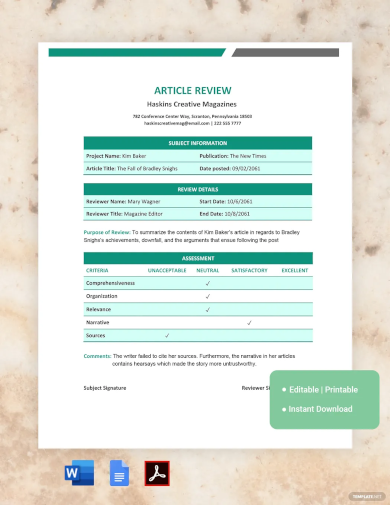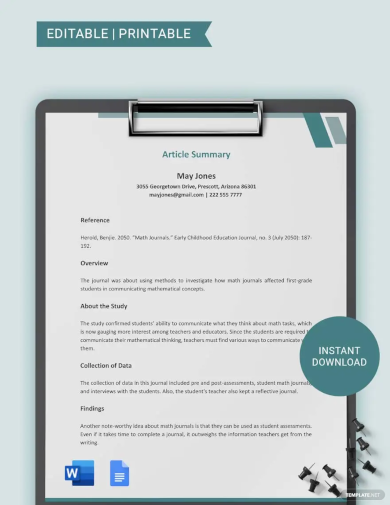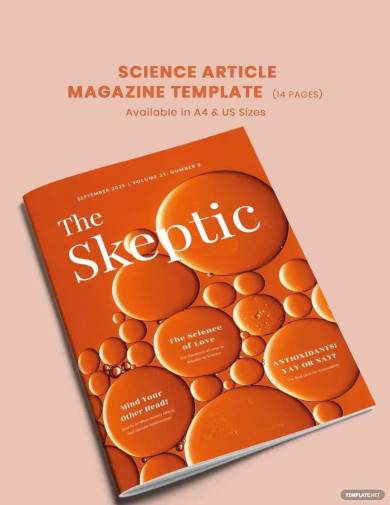Article
Are you someone who wants to write articles but doesn’t know where to start? Or are you a seasoned writer looking to take your article writing to the next level? Whatever your level of experience, this guide will provide you with everything you need to know about writing articles. From the definition of an article to step-by-step instructions on how to write one, we’ve got you covered. We’ll also explore different article writing examples, article proposals, sentences, informal letters, short obituaries, journal paper formats, introductions, conclusions, dialogues, books, and simple subjects. So, let’s get started.
What is an Article?
An article is a written composition on a particular topic, typically published in a newspaper, magazine, or website. It aims to inform or persuade the reader about a topic of interest, providing insight, analysis, and sometimes an opinion on the subject matter. Articles can take on different forms and styles, depending on the purpose and the intended audience.
Types of Article
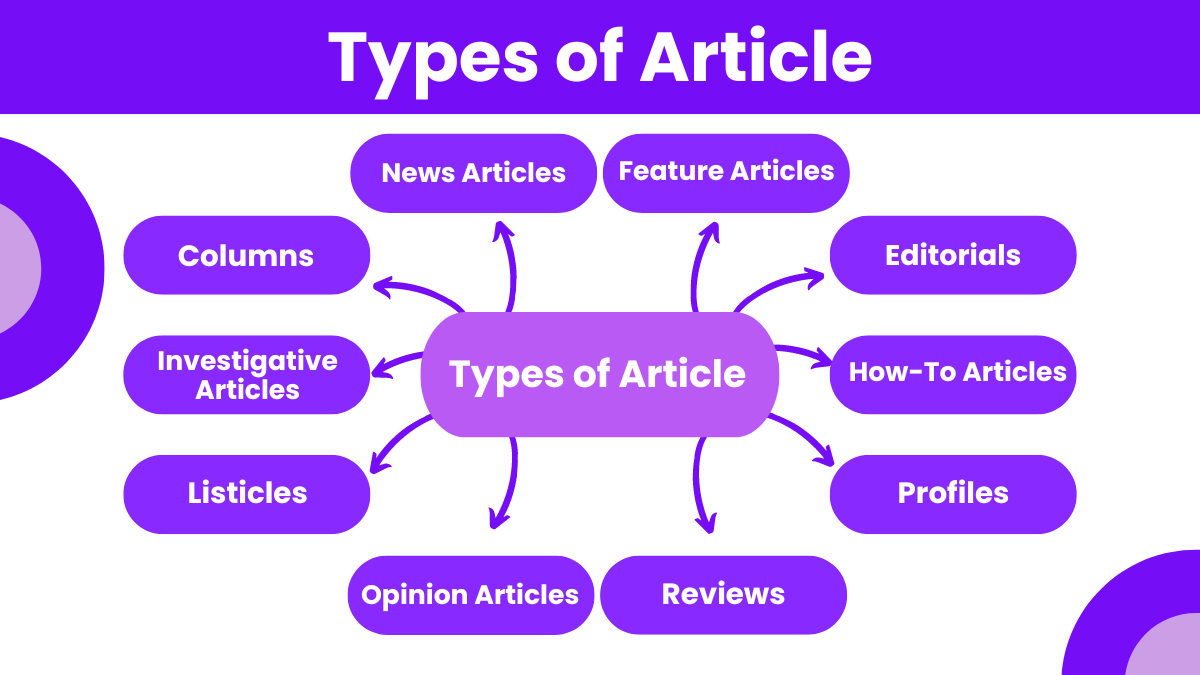
Articles are a versatile form of writing used to inform, persuade, entertain, or educate readers. Each type of article serves a distinct purpose and targets a specific audience. Below, we explore various types of articles commonly found in writing.
1. News Articles
News articles provide factual and timely information about current events. They are often found in newspapers, online news portals, and magazines.
Key Features:
- Objective tone
- Headline that captures attention
- Lead that summarizes the main point
- Inverted pyramid structure (most important information first)
- Quotations from relevant sources
2. Feature Articles
Feature articles delve deeper into a topic, providing a detailed analysis and exploring various angles. They often focus on human interest stories, trends, or cultural topics.
Key Features:
- Engaging narrative style
- In-depth research and background information
- Strong opening that hooks the reader
- Personal anecdotes and interviews
- Conclusions that provide insights or reflections
3. Editorials
Editorials express the opinions of the editorial board or the author on various issues. They aim to persuade readers and often appear in the opinion section of newspapers.
Key Features:
- Clear stance or opinion
- Strong, persuasive language
- Supporting arguments and evidence
- Call to action or recommendation
- Conclusion that reinforces the opinion
4. How-To Articles
How-to articles provide step-by-step instructions on how to accomplish a task or solve a problem. They are popular in blogs, magazines, and instructional websites.
Key Features:
- Clear and concise steps
- Detailed explanations
- Visual aids (images, diagrams, videos)
- Tips and warnings
- User-friendly language
5. Profiles
Profiles focus on an individual, highlighting their life, achievements, and impact. These articles often appear in magazines and newspapers.
Key Features:
- Detailed background information
- Interviews with the subject and others
- Descriptive language to paint a vivid picture
- Anecdotes and personal stories
- Analysis of the subject’s significance
6. Reviews
Reviews evaluate and critique products, services, events, or creative works such as books, movies, and music. They help readers make informed decisions.
Key Features:
- Summary of the item being reviewed
- Criteria for evaluation
- Objective and subjective analysis
- Strengths and weaknesses
- Final recommendation or rating
7. Opinion Articles
Opinion articles, also known as op-eds, express the personal views of the author on various topics. They are similar to editorials but are written by guest contributors.
Key Features:
- Personal voice and style
- Strong, clear opinion
- Supporting arguments and examples
- Engagement with counterarguments
- Conclusion that reinforces the viewpoint
8. Listicles
Listicles present information in a list format, making them easy to read and engaging. They are popular in online media and blogs.
Key Features:
- Catchy title
- Organized list of items (e.g., top 10, best of, etc.)
- Brief descriptions or explanations for each item
- Visual elements (images, GIFs)
- Entertaining or informative content
9. Investigative Articles
Investigative articles involve deep research to uncover facts, often about complex or controversial topics. They aim to inform the public and sometimes expose wrongdoing.
Key Features:
- Thorough research and fact-checking
- Detailed and systematic presentation
- Use of primary sources and documents
- Objective tone with clear evidence
- Impactful conclusions and revelations
10. Columns
Columns are regular articles written by the same author, often on a specific topic or theme. They build a relationship with readers through a consistent voice and perspective.
Key Features:
- Personal voice and opinion
- Regular publication schedule
- Focus on a specific theme or topic
- Engaging and conversational tone
- Interaction with readers through comments or letters
Examples of Article
Article Examples for Students
Understanding different types of articles and how they are written is essential for students. Here are examples of various article types that can help students grasp the basics of each style.
1. News Article
Headline: Local School Wins State Science Competition
Lead: The Central High School science team won first place in the state science competition held last Saturday, marking the third consecutive year they have taken home the top prize.
Body: Central High School’s science team, led by Dr. Sarah Thompson, competed against 20 other schools in the state finals. Their project, focused on renewable energy solutions, impressed the judges with its innovative approach and practical applications.
Quotes: “Our students worked incredibly hard, and it’s fantastic to see their efforts recognized at the state level,” said Dr. Thompson.
Conclusion: The team will advance to the national competition next month, where they hope to continue their winning streak.
2. Feature Article
Title: The Inspiring Journey of a Young Environmental Activist
Introduction: At just 16 years old, Emma Martinez has already made a significant impact in her community through her passionate advocacy for environmental conservation.
Body: Emma’s interest in environmental issues began in middle school when she learned about the effects of pollution on local wildlife. She started a school recycling program and organized community clean-up events. Her efforts have led to significant changes in local policies, including the implementation of stricter waste management regulations.
Personal Anecdotes: “I remember the first clean-up event we held; only a few people showed up. But now, our events attract hundreds of volunteers,” Emma shared.
Conclusion: Emma’s dedication to the environment serves as an inspiration to her peers and demonstrates the power of youth activism.
3. Editorial Example
Title: Why School Uniforms Should Be Mandatory
Introduction: The debate over school uniforms has been ongoing for years. However, the benefits of implementing a uniform policy far outweigh the drawbacks.
Body: Uniforms promote equality among students by reducing the visibility of socioeconomic differences. They also enhance school spirit and reduce distractions in the classroom. Additionally, uniforms can improve safety by making it easier to identify intruders on campus.
Supporting Arguments: Studies have shown that schools with uniform policies have lower rates of bullying and higher academic performance.
Conclusion: Mandating school uniforms can create a more focused and inclusive learning environment for all students.
4. How-To Article
Title: How to Write a Strong Thesis Statement
Introduction: A strong thesis statement is crucial for any academic essay. It clearly states the main point of your paper and guides your writing.
Steps:
- Understand Your Topic: Make sure you have a thorough understanding of your topic before you begin writing.
- Narrow Your Focus: Your thesis statement should be specific and address a particular aspect of your topic.
- Take a Stand: Clearly state your position or argument.
- Provide Reasons: Include the main reasons that support your argument.
- Revise and Refine: Review your thesis statement to ensure it is clear and concise.
Conclusion: A well-crafted thesis statement lays the foundation for a strong essay. By following these steps, you can create a thesis statement that effectively communicates your main point.
5. Profile Example
Title: Meet Jane Doe: The Teacher Making a Difference
Introduction: Jane Doe has been teaching at Lincoln Elementary for over 20 years, and her dedication to her students is evident in everything she does.
Body: Jane started her career as a teacher’s aide before earning her teaching degree. Over the years, she has developed innovative teaching methods that engage and inspire her students. Her classroom is known for its welcoming atmosphere and creative projects.
Interviews: “Ms. Doe always goes above and beyond to help her students succeed,” said one parent. “She makes learning fun and accessible for everyone.”
Conclusion: Jane Doe’s passion for teaching has touched the lives of countless students and has made her a beloved figure in the community.
6. Review Example
Title: Book Review: “The Great Gatsby” by F. Scott Fitzgerald
Summary: “The Great Gatsby” is a classic novel that explores themes of wealth, love, and the American Dream in the 1920s.
Evaluation: Fitzgerald’s writing is both poetic and precise, capturing the essence of the Jazz Age. The characters are complex and well-developed, particularly Jay Gatsby, whose tragic quest for love and acceptance drives the narrative.
Strengths: The novel’s vivid descriptions and poignant social commentary make it a timeless piece of literature.
Weaknesses: Some readers may find the pacing slow, particularly in the middle sections.
Conclusion: “The Great Gatsby” remains a must-read for its brilliant prose and enduring themes.
7. Opinion Article
Title: The Importance of Learning a Second Language
Introduction: In today’s globalized world, learning a second language is more important than ever.
Body: Being bilingual opens up numerous opportunities for personal and professional growth. It enhances cognitive abilities, improves communication skills, and increases cultural awareness. Additionally, many employers seek candidates who can speak multiple languages.
Supporting Arguments: Research shows that bilingual individuals have better problem-solving skills and are more adept at multitasking.
Conclusion: Investing time in learning a second language is an investment in your future. It not only broadens your horizons but also provides a competitive edge in the job market.
8. Listicle Example
Title: Top 10 Study Tips for High School Students
Introduction: High school can be challenging, but with the right study habits, you can achieve academic success.
List:
- Create a Study Schedule: Plan your study time and stick to it.
- Take Breaks: Short breaks can help maintain focus and prevent burnout.
- Use Study Groups: Collaborating with peers can provide new insights and make studying more enjoyable.
- Stay Organized: Keep your notes and materials organized to save time.
- Practice Active Reading: Engage with the material by highlighting and taking notes.
- Teach What You’ve Learned: Explaining concepts to others reinforces your understanding.
- Stay Positive: Maintain a positive attitude and stay motivated.
- Get Enough Sleep: Adequate rest is crucial for effective learning.
- Eat Healthily: Proper nutrition can boost concentration and energy levels.
- Seek Help When Needed: Don’t hesitate to ask teachers or tutors for assistance.
Conclusion: By incorporating these study tips into your routine, you can improve your academic performance and make the most of your high school experience.
Example of Article for Newspaper
Title: Local Community Rallies to Support Flood Victims
By: Jane Doe, Staff Writer
In an extraordinary display of solidarity, the residents of Riverdale have come together to aid those affected by the recent floods. The disaster, which struck the small town last week, has left hundreds of families displaced and in urgent need of assistance.
Immediate Response
As the floodwaters began to rise, local authorities acted swiftly to evacuate residents from the most affected areas. The Riverdale Community Center was quickly converted into a temporary shelter, providing refuge for over 200 people. Volunteers from various community organizations have been working around the clock to ensure that the needs of these displaced families are met.
“We couldn’t just sit by and watch our neighbors suffer,” said Mary Johnson, a volunteer with the Riverdale Red Cross. “Everyone has come together, donating food, clothing, and their time to help those in need.”
Community Efforts
The response from the community has been overwhelming. Local businesses have donated supplies, and schools have organized fundraising events to support relief efforts. The Riverdale High School football team, for example, held a charity car wash over the weekend, raising over $5,000.
“We wanted to do something to help,” said team captain, John Smith. “Seeing the devastation firsthand motivated us to take action.”
Government Support
In addition to community efforts, state and federal agencies have stepped in to provide assistance. Governor Lisa Brown visited Riverdale on Tuesday, promising swift aid to rebuild the town’s infrastructure.
“The resilience and unity displayed by the people of Riverdale is truly inspiring,” said Governor Brown. “We are committed to providing all necessary resources to help this community recover and rebuild.”
Looking Ahead
While the immediate response has been robust, the road to recovery will be long. Many homes and businesses have been severely damaged, and the community faces the daunting task of rebuilding. Local leaders are urging residents to continue their support in the coming weeks and months.
“The initial response has been fantastic, but we must keep this momentum going,” said Mayor Tom Lewis. “There is still much work to be done, and we need everyone’s help to ensure that Riverdale comes back stronger than ever.”
As the waters begin to recede, the spirit of Riverdale remains unbroken. With the continued support of its residents and the broader community, there is hope that this resilient town will soon be back on its feet.
Contact Information:
For those wishing to contribute to the relief efforts, donations can be made at the Riverdale Community Center or through the Red Cross website.
About the Author:
Jane Doe is a staff writer for the Riverdale Gazette, covering local news and community events. She can be reached at janedoe@riverdalegazette.com.
Example of Article for Magazine
Title: The Art of Mindful Living: Transforming Everyday Moments
By: Emily Carter, Lifestyle Editor
In our fast-paced, technology-driven world, finding moments of peace and clarity can seem like an impossible task. Yet, the practice of mindful living offers a beacon of hope, transforming even the most mundane tasks into opportunities for tranquility and self-discovery. In this article, we explore the essence of mindful living and provide practical tips to help you integrate mindfulness into your daily routine.
What is Mindful Living?
At its core, mindful living is the practice of being fully present and engaged in the moment, free from distractions and judgment. It involves paying attention to your thoughts, feelings, and sensations with a sense of curiosity and openness. By cultivating mindfulness, you can enhance your overall well-being and experience a deeper connection to yourself and the world around you.
The Benefits of Mindfulness
Research has shown that mindfulness can lead to numerous physical and mental health benefits. These include reduced stress, improved focus, enhanced emotional regulation, and better sleep. Moreover, mindfulness can foster a greater sense of empathy and compassion, enriching your relationships and interactions with others.
Practical Tips for Incorporating Mindfulness
- Start Your Day with Intention
Begin your morning with a few minutes of mindful breathing. Sit comfortably, close your eyes, and take deep breaths, focusing on the sensation of the air entering and leaving your body. Set a positive intention for the day ahead, such as “I will approach today with calm and clarity.”- Mindful Eating
Instead of rushing through meals, take the time to savor each bite. Pay attention to the flavors, textures, and aromas of your food. Eating mindfully can enhance your enjoyment of meals and promote better digestion.- Mindful Movement
Whether it’s yoga, walking, or stretching, incorporate mindful movement into your routine. Focus on the sensations in your body as you move, and tune into your breath. This can help you feel more grounded and connected to your body.- Digital Detox
Set aside specific times during the day to disconnect from digital devices. Use this time to engage in activities that bring you joy, such as reading, gardening, or spending time with loved ones. Reducing screen time can help you feel more present and less overwhelmed.- Gratitude Practice
Each evening, take a moment to reflect on three things you are grateful for. This simple practice can shift your focus from what is lacking to what is abundant in your life, fostering a sense of contentment and positivity.Mindfulness in Everyday Tasks
Mindfulness isn’t limited to formal meditation practices. You can bring mindfulness to everyday tasks, transforming them into moments of peace and reflection. For example, while washing dishes, focus on the sensation of the warm water and the texture of the soap. When driving, pay attention to the sights and sounds around you, staying fully present.
Conclusion
Integrating mindfulness into your daily life doesn’t require drastic changes. By incorporating simple practices and being intentional about your actions, you can cultivate a more mindful and fulfilling life. Remember, mindfulness is a journey, not a destination. Embrace each moment with an open heart and mind, and discover the profound impact it can have on your well-being.
About the Author:
Emily Carter is the Lifestyle Editor at Harmony Magazine. With a passion for wellness and personal growth, she writes about mindfulness, self-care, and holistic living. When she’s not writing, Emily enjoys hiking, practicing yoga, and exploring new ways to live a mindful life. Follow her journey on Instagram @emilycarter_wellness.
Technical Article Writing Example
Implementing Machine Learning for Predictive Analytics in Healthcare
By: Dr. John Smith, Data Scientist
Introduction
Machine learning (ML) is revolutionizing predictive analytics in healthcare, aiding in early disease detection, patient outcome prediction, and resource optimization. This article explores key ML algorithms, their applications, and implementation challenges.
Key Machine Learning Algorithms
- Linear Regression: Predicts patient outcomes from continuous variables, e.g., hospital readmission rates.
- Logistic Regression: Classifies patients into categories, e.g., diabetes prediction.
- Decision Trees: Diagnoses diseases by evaluating symptoms.
- Random Forest: Combines multiple decision trees for accuracy, e.g., predicting surgery survival rates.
- Support Vector Machines (SVM): Classifies high-dimensional data, e.g., identifying cancerous cells.
- Neural Networks: Analyzes large datasets, e.g., detecting abnormalities in medical imaging.
Implementation Steps
- Data Collection and Preprocessing: Gather and clean data from electronic health records and medical devices.
- Feature Selection: Identify relevant features influencing outcomes, reducing dimensionality.
- Model Selection: Choose the appropriate ML algorithm based on the problem.
- Model Training: Train the model and validate it using cross-validation.
- Model Evaluation: Assess performance using accuracy, precision, and recall.
- Model Deployment: Integrate the model into clinical workflows and monitor performance.
Challenges
- Data Privacy and Security: Comply with regulations and implement robust encryption.
- Data Quality and Availability: Ensure access to high-quality, labeled datasets.
- Model Interpretability: Make complex models interpretable for clinicians.
- Integration with Existing Systems: Ensure seamless integration with healthcare IT systems.
Applications
- Early Disease Detection: Identifying early signs of diseases from imaging data.
- Predictive Maintenance of Medical Equipment: Scheduling timely maintenance.
- Personalized Treatment Plans: Tailoring treatments based on patient data.
- Operational Efficiency: Optimizing resource allocation in hospitals.
Conclusion
Machine learning has the potential to transform healthcare by enabling data-driven decisions and improving patient outcomes. Despite challenges, advancements in ML continue to drive innovative healthcare solutions.
About the Author:
Dr. John Smith is a Data Scientist with a Ph.D. in Biomedical Informatics. With over a decade of experience in healthcare data, he is passionate about using technology to improve patient care. Connect with him on LinkedIn at linkedin.com/in/drjohnsmith.
Short Article Writing Example
The Future of Renewable Energy: Solar Power’s Promising Potential
By: Sarah Johnson, Environmental Journalist
In recent years, renewable energy has gained significant traction as a sustainable alternative to fossil fuels. Among the various renewable sources, solar power stands out for its vast potential and numerous benefits. As the world grapples with climate change and environmental degradation, solar energy offers a beacon of hope for a cleaner, greener future.
Harnessing the Sun’s Power
Solar power harnesses energy from the sun using photovoltaic (PV) cells. These cells convert sunlight directly into electricity, providing a clean, renewable source of energy. Solar panels, composed of numerous PV cells, can be installed on rooftops, open fields, and even floating on water bodies, making them versatile and adaptable to different environments.
Advantages of Solar Energy
- Environmental Impact
Solar energy produces no greenhouse gases or pollutants, significantly reducing the carbon footprint. It helps mitigate climate change and reduces air and water pollution.- Economic Benefits
The cost of solar panels has dropped dramatically over the past decade, making solar energy more affordable. Governments and private sectors are investing in solar projects, creating jobs and stimulating economic growth.- Energy Independence
Solar power reduces reliance on imported fuels, enhancing energy security. Communities and countries can generate their own electricity, decreasing vulnerability to global energy market fluctuations.Challenges and Innovations
While solar power is promising, it faces challenges such as energy storage and efficiency. Solar energy is intermittent, as it depends on sunlight availability. However, advancements in battery technology and energy storage solutions are addressing these issues, ensuring a steady power supply even when the sun isn’t shining.
The Road Ahead
The future of solar power is bright, with continued innovations and investments driving its growth. Governments worldwide are setting ambitious targets for solar energy adoption, integrating it into national grids, and supporting research and development.
Conclusion
Solar power is a key player in the transition to renewable energy. Its environmental, economic, and energy security benefits make it a vital component of a sustainable future. As technology advances and adoption increases, solar energy has the potential to become a primary source of power, illuminating the path to a cleaner planet.
About the Author:
Sarah Johnson is an environmental journalist dedicated to covering topics related to sustainability and renewable energy. With a background in environmental science, she aims to raise awareness about the importance of transitioning to cleaner energy sources. Follow her work on Twitter @SarahJ_Eco.
Scientific Research Article
Analyzing the Impact of Microplastics on Marine Ecosystems
By: Dr. Alex Thompson, Marine Biologist
Abstract
Microplastics, tiny plastic particles less than 5mm in size, have become pervasive in marine environments. This study investigates the sources, distribution, and ecological impact of microplastics on marine ecosystems. Through field sampling, laboratory analysis, and ecological assessment, we provide a comprehensive understanding of microplastic pollution and its consequences for marine life.
Introduction
Microplastics have emerged as a significant environmental concern due to their persistence and ubiquity in marine ecosystems. Originating from various sources, including the breakdown of larger plastic debris and the release of microbeads from personal care products, these particles are ingested by marine organisms, potentially causing harm. This research aims to elucidate the pathways and impacts of microplastic pollution in marine environments.
Methodology
- Field Sampling
- Locations: Coastal and offshore sites in the North Atlantic Ocean.
- Collection: Surface water and sediment samples using neuston nets and sediment corers.
- Laboratory Analysis
- Identification: Visual sorting and Fourier-transform infrared (FTIR) spectroscopy to identify and quantify microplastic particles.
- Biological Impact: Feeding trials with marine invertebrates (e.g., copepods, mussels) to assess ingestion and physiological effects.
- Ecological Assessment
- Biodiversity Surveys: Comparing regions with varying levels of microplastic contamination.
- Data Analysis: Statistical analysis to correlate microplastic concentration with observed ecological impacts.
Results
- Distribution
- Microplastics were found in all sampled locations, with higher concentrations in coastal areas compared to offshore sites.
- Predominant types included polyethylene, polypropylene, and polystyrene particles.
- Ingestion by Marine Organisms
- Ingestion was confirmed in multiple species, including plankton, bivalves, and fish.
- Negative effects observed included reduced feeding rates, impaired growth, and increased mortality in some species.
- Ecological Impact
- Areas with high microplastic concentrations exhibited reduced biodiversity and altered community structures.
- Key species, such as filter feeders, showed significant declines, impacting the broader food web.
Discussion
The widespread presence of microplastics in marine environments poses significant threats to marine life and ecosystem health. The ingestion of microplastics can lead to physical and chemical stress in organisms, potentially disrupting marine food webs. Efforts to mitigate microplastic pollution should focus on reducing plastic production and improving waste management practices to prevent plastic debris from entering marine systems.
Conclusion
Microplastics represent a critical environmental challenge with far-reaching implications for marine ecosystems. Our study highlights the urgent need for concerted efforts to address plastic pollution and protect marine biodiversity. Further research is needed to fully understand the long-term effects of microplastics and develop effective strategies to mitigate their impact.
References
- Galloway, T. S., & Lewis, C. N. (2016). Marine microplastics spell big problems for future generations. Proceedings of the National Academy of Sciences, 113(9), 2331-2333.
- Law, K. L., & Thompson, R. C. (2014). Microplastics in the seas. Science, 345(6193), 144-145.
- Wright, S. L., Thompson, R. C., & Galloway, T. S. (2013). The physical impacts of microplastics on marine organisms: A review. Environmental Pollution, 178, 483-492.
About the Author:
Dr. Alex Thompson is a Marine Biologist specializing in marine pollution and its ecological impacts. With over 15 years of research experience, Dr. Thompson has published extensively on marine conservation and is committed to advancing scientific understanding to protect ocean health.
More Samples & Examples of Article in PDF
1. Article Review Template
2. Article Summary Template
3. Articles of Association Template
4. Science Article Magazine Template
5. Simple Article Writing
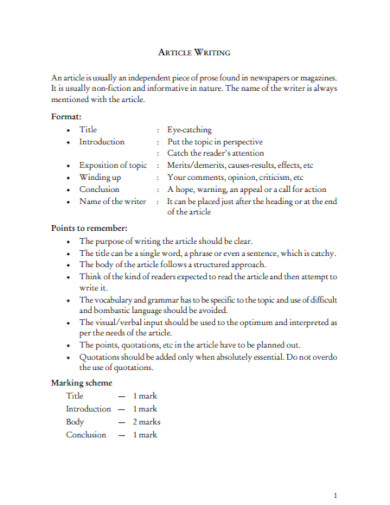
wps.pearsoned.com
Importance of Article
Articles are essential for written communication, providing valuable information, fostering public discourse, and contributing to education and entertainment.
1. Information Dissemination
Articles keep the public informed about current events, scientific discoveries, health tips, and technological advancements.
Examples:
- News articles update on local, national, and global events.
- Health articles inform about medical conditions and treatments.
2. Education
Articles break down complex subjects into understandable segments, aiding in learning and knowledge acquisition.
Examples:
- Academic articles present research findings.
- How-to articles offer step-by-step instructions.
3. Public Discourse and Opinion Formation
Opinion articles and editorials encourage critical thinking and discussions, influencing public opinion and societal change.
Examples:
- Editorials discuss political, social, and economic issues.
- Opinion pieces provide personal perspectives on various topics.
4. Entertainment
Articles provide engaging content that entertains while offering insights into culture, lifestyle, and human interest stories.
Examples:
- Feature articles explore fascinating topics.
- Reviews help readers discover new entertainment options.
5. Professional Development
Industry-specific articles offer updates on trends, best practices, and professional advice, enhancing careers.
Examples:
- Industry articles discuss the latest trends.
- Professional development articles offer career advice.
6. Marketing and Branding
Articles are powerful for marketing, sharing expertise, promoting products, and connecting with the audience.
Examples:
- Blog articles provide useful industry information.
- Guest articles increase brand visibility.
7. Preservation of History
Articles record historical events and cultural moments, providing valuable insights for future generations.
Examples:
- Historical articles document major events.
- Cultural articles capture societal changes.
How to Write an Article
Writing an article can seem like a daunting task, but with the right approach, anyone can do it. Here’s a step-by-step guide on how to write an article:
Step 1: Choose a topic
Determine what you want to write about and conduct research to gather information on your chosen subject.
Step 2: Develop an outline
Create a structure for your article that includes an introduction, body, and conclusion. Your outline should also include the main points you want to cover and the supporting evidence you’ll use to back them up.
Step 3: Write the introduction
Start with a hook to grab your reader’s attention, and then provide background information on your topic. Your introduction should set the stage for the rest of your article and give readers an idea of what to expect.
Step 4: Write the body
Organize your research into paragraphs that develop your argument or provide insight into your subject. Each paragraph should focus on a single point, and you should use transition words to link them together.
Step 5: Write the conclusion
Summarize your main points and leave the reader with a clear takeaway. Your conclusion should provide closure to your article and reiterate your main message.
Step 6: Edit and revise
Polish your article by reviewing for grammar, punctuation, and spelling errors, and consider revising for clarity, flow, and structure.
What are the main types of articles?
The main types are news articles, feature articles, editorials, how-to articles, profiles, reviews, opinion articles, listicles, investigative articles, and columns.
How do you structure a news article?
A news article typically follows an inverted pyramid structure: headline, lead (summary), body (detailed information), and conclusion (additional context or future outlook).
What makes a good feature article?
A good feature article is engaging, well-researched, and narrative-driven. It includes detailed background information, personal anecdotes, and interviews, ending with insightful conclusions.
How do you write a strong thesis statement?
A strong thesis statement clearly presents the main point or argument, is specific and concise, and guides the structure of the essay or article.
What is the purpose of an editorial?
An editorial expresses the opinions of the editorial board or author, aiming to persuade readers about a particular issue, supported by arguments and evidence.
How do you start a how-to article?
Start with an engaging introduction that explains the importance of the task, followed by clear, numbered steps, and include tips, warnings, and visual aids if necessary.
What is a profile article?
A profile article focuses on an individual, highlighting their life, achievements, and impact through detailed background information, interviews, and personal stories.
How do you write an effective review?
Summarize the item being reviewed, evaluate its strengths and weaknesses, provide objective and subjective analysis, and conclude with a recommendation or rating.
What are listicles, and why are they popular?
Listicles present information in a list format, making content easy to read and engaging. They are popular for their simplicity, visual appeal, and quick consumption.
What is the importance of articles in writing?
Articles inform, educate, entertain, and engage readers, contributing to personal growth, societal development, and professional advancement, making them a vital form of communication.




